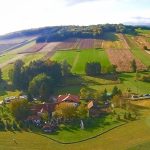February 17, 2020 – It is almost 450 years since the famous Peasants Revolt of 1573, but the memory and tradition live on each year in Donja Stubica.
In the mystery of the misty hills of Zagorje, last weekend, you could hear a strange noise. While one voice screams, “Bunaaa!” (The Revolt), hundreds of others reply, “Trajeee!” (lasts). All of that followed by the rattle of weapons. The place: Donja Stubica, Hrvatsko Zagorje. Year: 1573. Why does it matter? Croatians took the courage to confront the authorities.
On the night of January 27-28, 1573, the famous Peasant Revolt led by Matija Gubec began with an attack on Cesargrad. Reasons for the rebellion were multiple, with the chief increase in giving and terror by royalty. Among the most famous is the violence of the pillar owner Franjo Tahy, especially against peasant women. His four sons also joined him in inhumane actions against his serfs, so the peasants’ resistance to the Tahi estate began as early as 1571. The farmers refused to return under Tahi’s rule and start to get serious. They formed a kind of peasant government, headed by Gubec, whom they called a bey.
After complaining in vain to the king about the atrocities of the nobles, the villagers stopped paying unreasonable taxes in protest. Subsequently, Tahy sent in his armed mercenaries, but armed villagers readily welcomed them. Due to this resistance, the Croatian Parliament, headed by Ban Juraj Draškovic, declared the peasants’ traitors to their homeland.
The news of the Zagreb conviction vigorously shook the entire peasantry in Croatia and Slovenia. They began heavily arming themselves, and the peasant revolt spread with increasing speed, and the serfs in these areas began to cancel obedience to their masters. A war plan was also drawn up, according to which peasants gathered around Matija Gubec, and Ivan Pasanac were to remain in Donja Stubica (where the main focal point of the rebellion was) as part of an army that would defend the area.
Ilija Gregorić led the peasants from Cesargrad, who were the originators of the revolt. Soon the rebellion spread throughout Carniola and Styria, and units of serfs fought bravely and conquered more and more land, including the area between Brežice and Mokrice. Their goals, the abolition of feudalism and the seizure of power by establishing a kind of imperial province in Zagreb, were ever closer.
Then there was a breakthrough. Namely, the Žumberak Uskoci, well-armed and experienced soldiers counted by the peasants, after a short hesitation, put themselves on the side of the feudal lords (who richly rewarded them for that). On 5 February 1573, the peasant army experienced its first defeat at Krško, routed by the Uskok troops led by Captain Thurn. In the battles of Kerestinec, Mokrica, and Krško, a large number of peasants were killed, which discouraged them, and their continued resistance in these areas was increasingly weakened. The army sent by the great men was steadily increasing, and it was the beginning of the end of the Croatian-Slovenian peasant revolt.
The decisive battle took place on 9 February 1573 at Stubičke Toplice. The royal army was led by Gašpar Alapić (later Croatian Ban), and when Matija Gubec realized that the royal soldiers were approaching them, he decided to fight to the end. At first, the peasants fought bravely, but numerical superiority and weaponry were certainly not on their side, and defeat was imminent. Mogaić was killed on the battlefield as were many other peasants, and many were captured.
Matija Gubec and Ivan Pasanec were brought to Zagreb and brutally executed on St Mark’s Square on 15 February, 1573. According to legend, Gubec had to wear a blazing crown on his head, after which the Hungarian landlord Morencz Bahiczy cut Matija into several pieces.
On a cold winter’s day every year for the past 12 years, hundreds of reenactments take place on the field of Donja Stubica to repeat this piece of history. The main organizers are Družba vitezova Zlatnog Kaleža, while more than 20 medieval groups reconstruct the historical battle. One of them was Knight Order of Saint Nicholas Varaždin, about whom you can read here. Every year there are more and more visitors, so now we are talking about over 20 thousand people. This reenactment event got the “Simply the Best” award for the best historical display and tourist event. The whole event was accompanied by a cultural art program, a fair of old crafts, and the reconstruction of a medieval village with a gastronomic offer from that time. Kids learn about the Peasant Revolt kids in school, we read about it in books, and one Croatian band even sing about it! In case this topic got your attention more than usually, here is the movie Anno Domini 1573.
If you missed it this year, be prepared for the next time, because remember… The Revolt, lasts!










